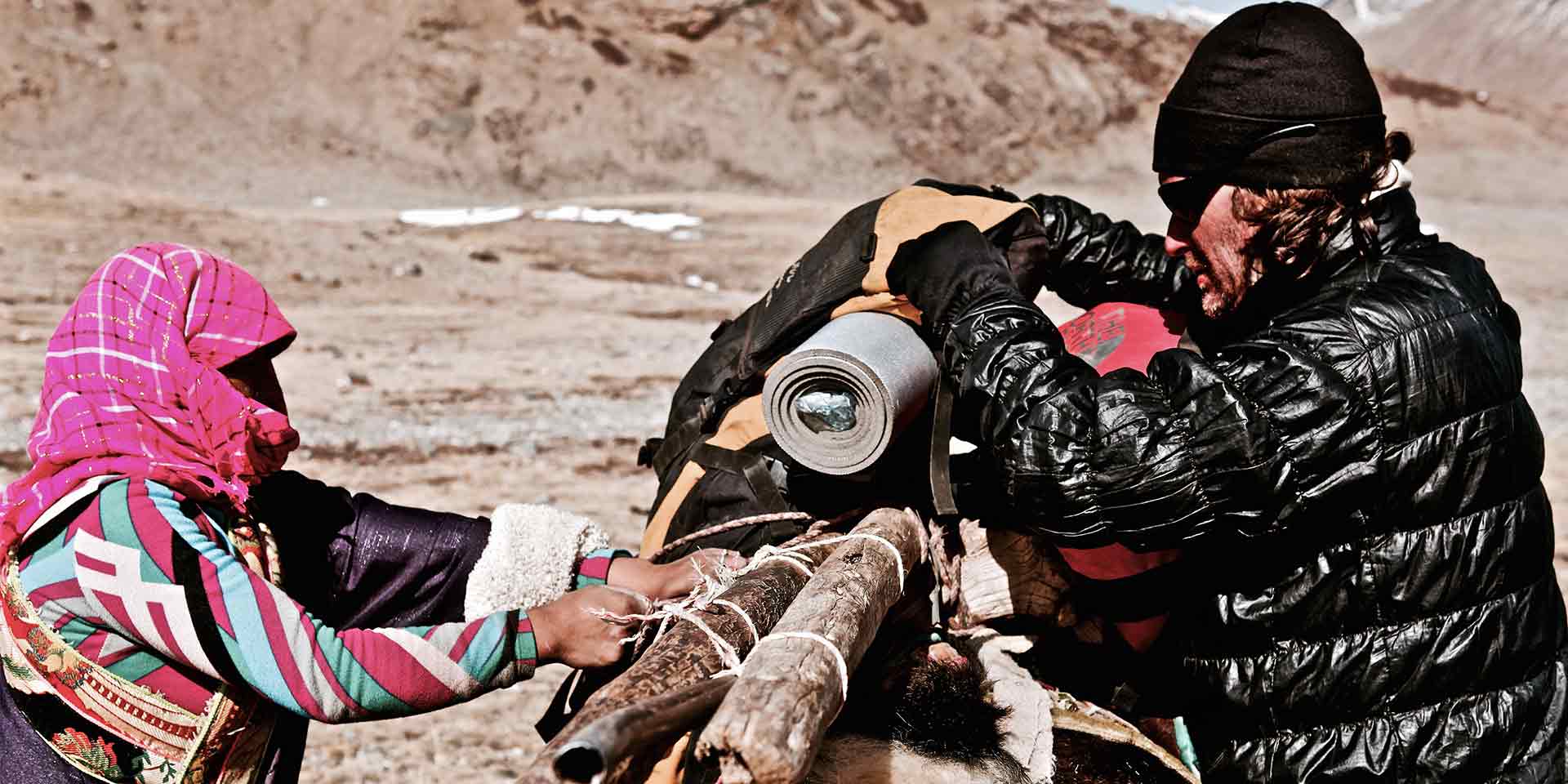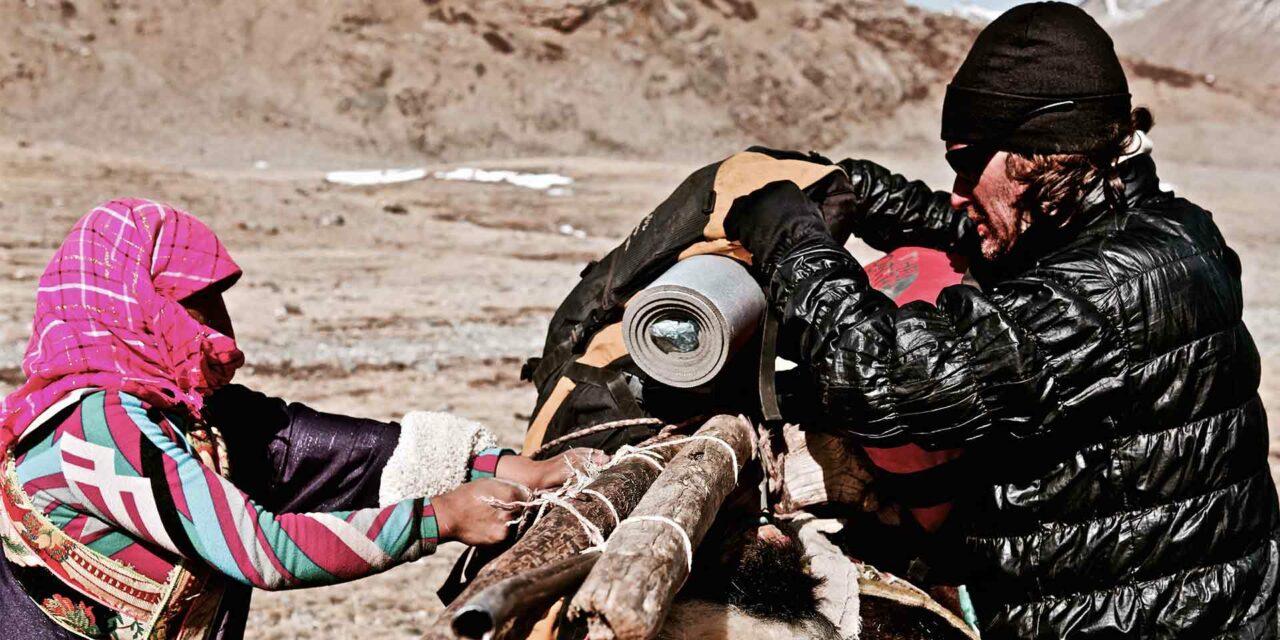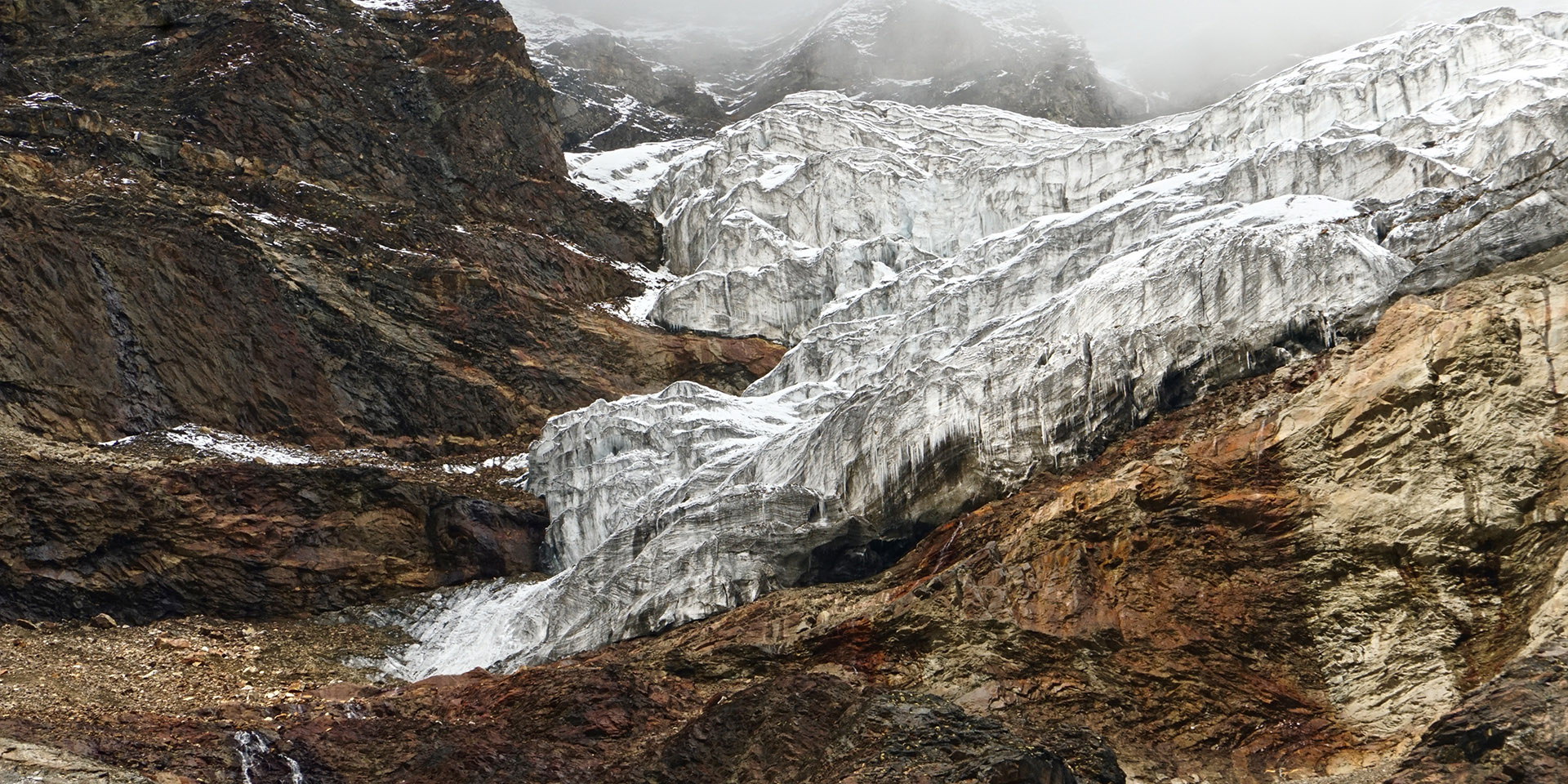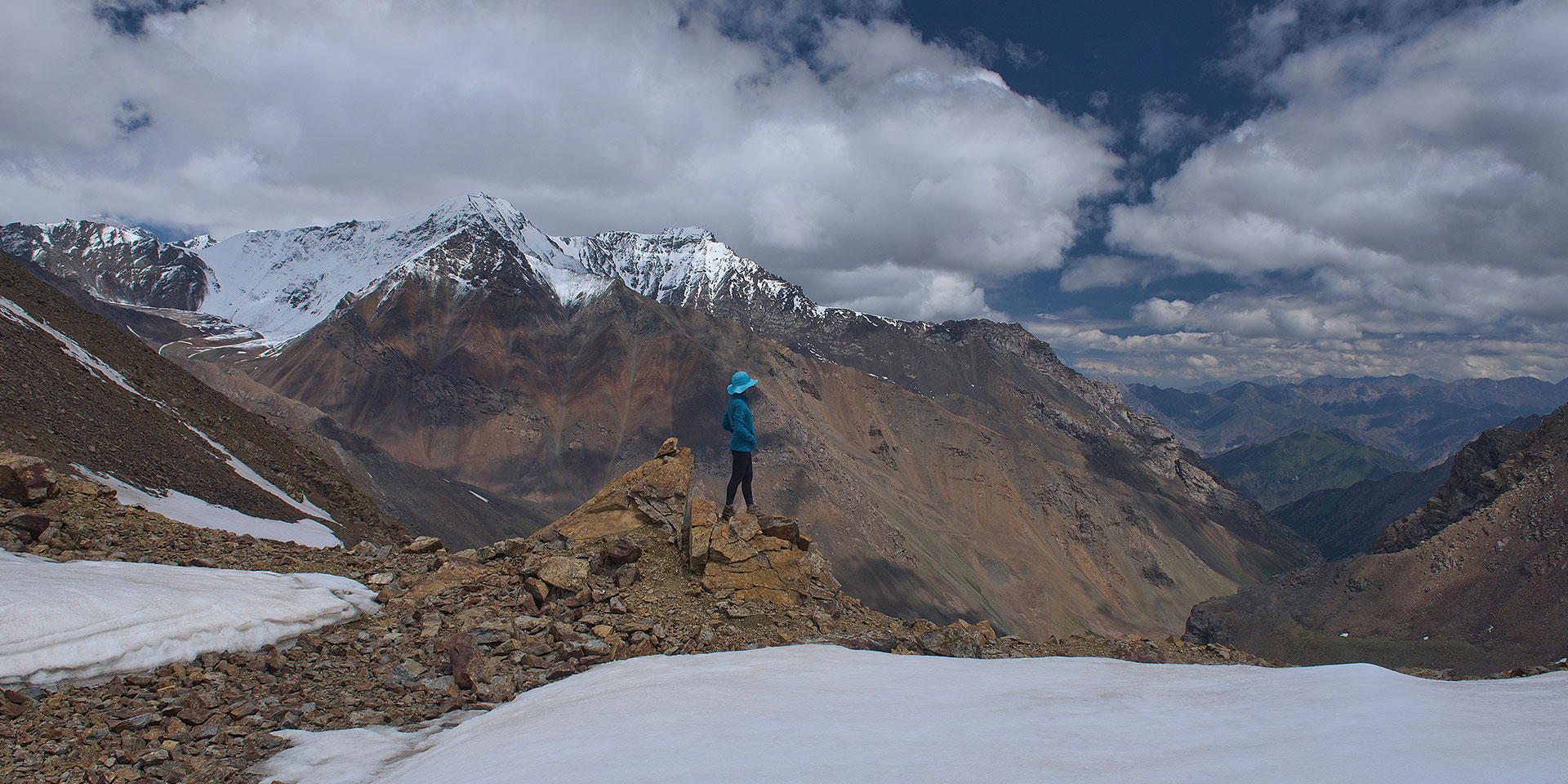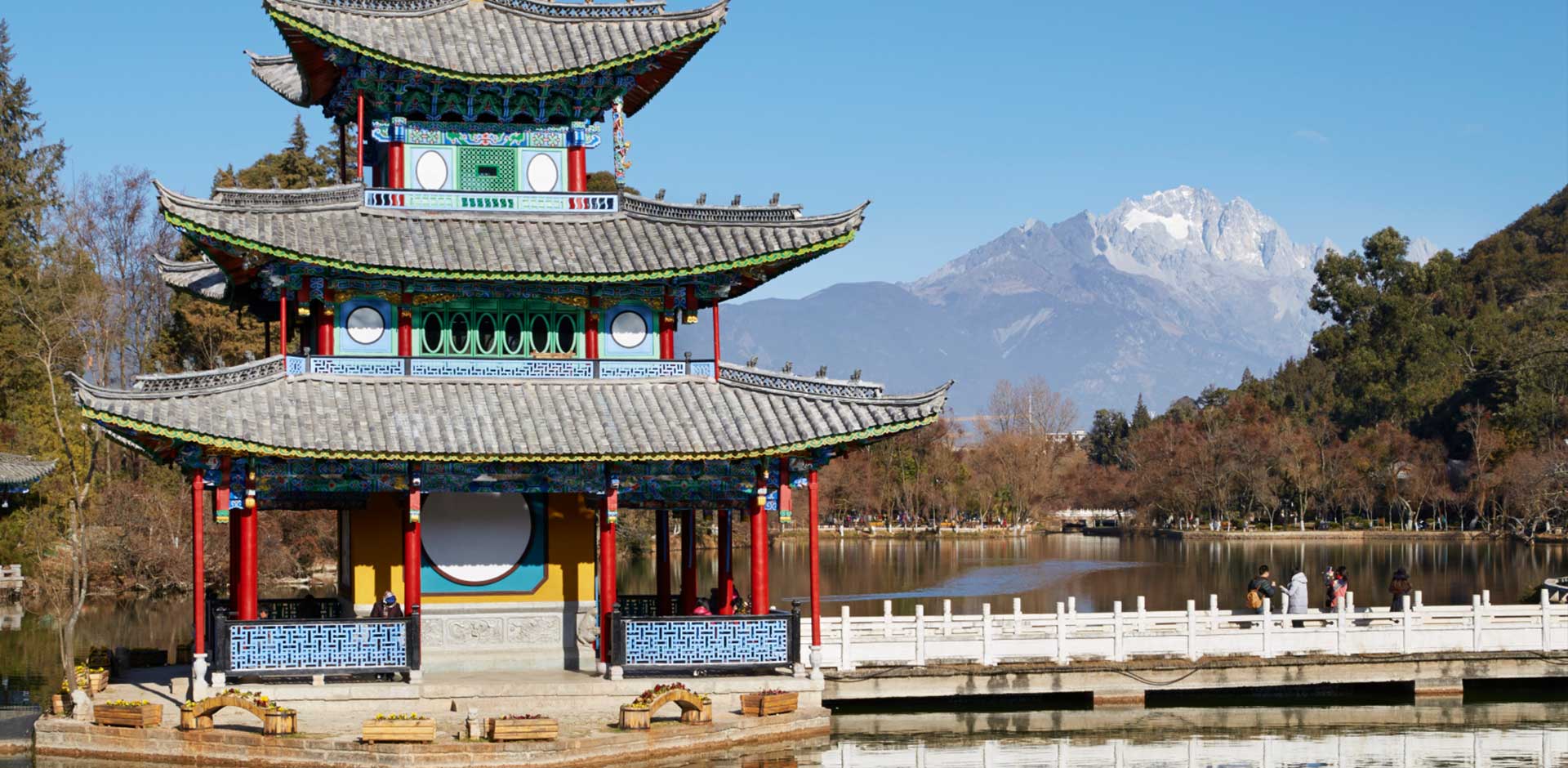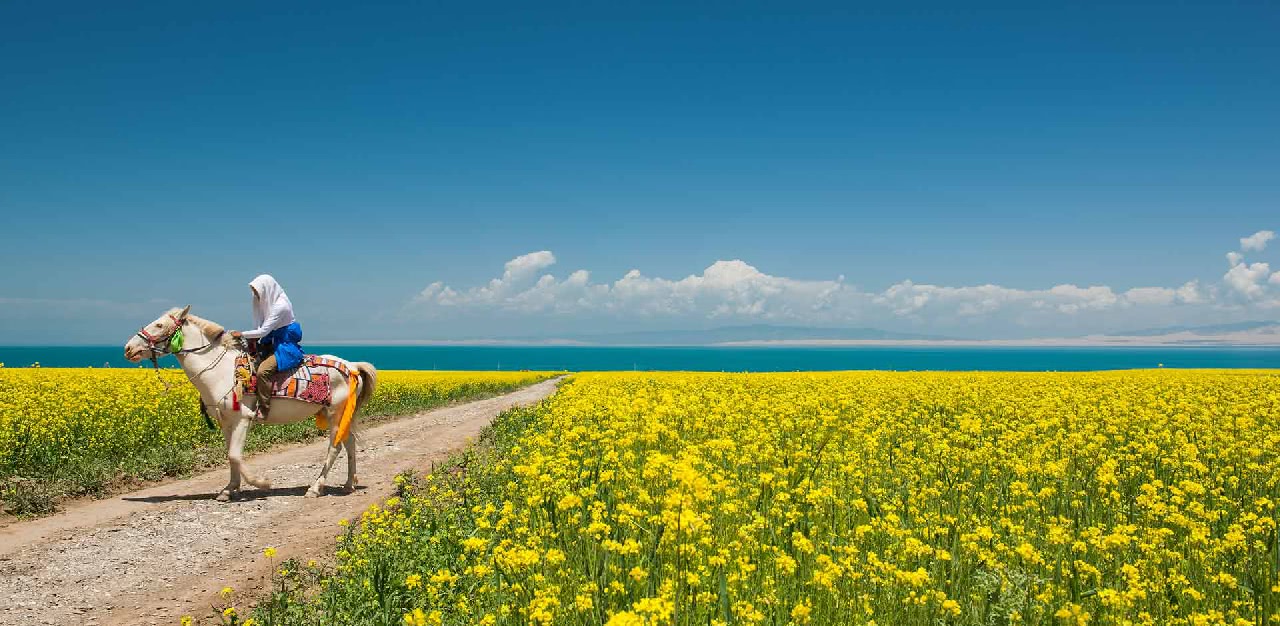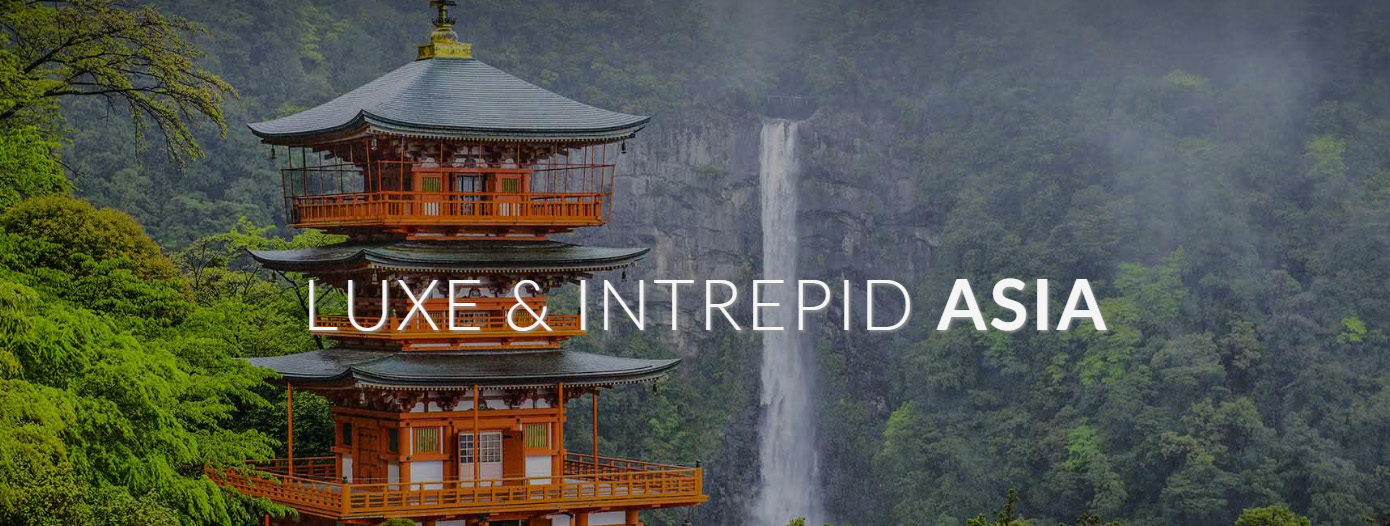Header Image: Gamzon our guide instructs on yak loading and ‘nomad’ knot tightening as we gear up near Amne Maqin.
“If one had salt or tea, one was rich, one could live.” These words, spoken slowly come out of a lined and haunted face, the mouth barely moving. It is a face that is worn and enlightened by eight decades in the full of Mother Nature’ whims, at close to five kilometers above sea level. Wangdu’s long hands smoothly work their way through the 108 beads on a japa mala (Buddhist rosary) as he speaks. We sit tucked away near Darlag in south-western Qinghai province, in a hut that reverberates with wind that rips. Wangdu has a kind of languid elegance to his still-powerful body and he gazes somewhere above me as he searches his memory.
The Tsa’lam, the nomadic route of salt, was known to only a handful who traveled its dust and snow-blown length. Wangdu is one of those few ancients I had met who recalled a time when tsa, (salt) was slung onto the backs of yak and transported.
Thus the idea of journeying along this old forgotten Himalayan route was born.
Tsam Tso – The Lake of Salt
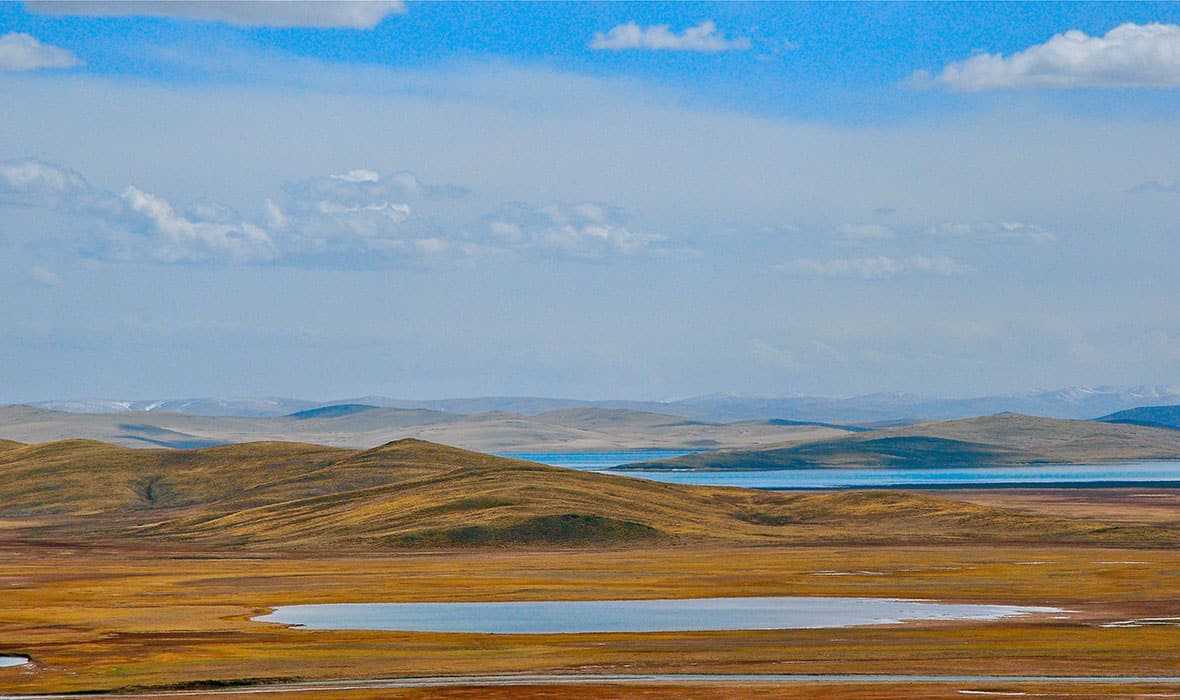
ABOVE:A series of high mountain lakes lie in southern Qinghai province. In amidst these clear lakes in times past, there would be salt lakes which were sooty and milky coloured. Those salt lakes have all but disappeared as the sun and wind have evaporated their contents.
Within the framework of Himalaya trader-speak, distances and timeframes are referred to in measurements far more to do with landmarks than time. The traders of old and many Tibetans might refer to a journey as being a trip of “eight valleys and four passes”, which might work out to being three weeks. The Salt Road journeys were themselves measured this way.
From the borderlands of Sichuan to the salt lake, journeys took between two and three weeks. Trek partner Michael Kleinwort and I are on pace but we’ve managed to avoid blizzards, bandits, and disorientation. We are in Qinghai Province’s southern portion and the only consistencies thus far in our trek days are big skies and loads of tea.
Our own journey is somewhat hobbled by the fact that with so few remembering the route we are often totally off base, until someone – usually an elder – guides us in the right direction. There are times when Michael and I fall into silences that last hours as we make our way overland – it is a place that defies descriptions. Getting lost in these lands is easy when the senses are so engaged with the expanse of space.
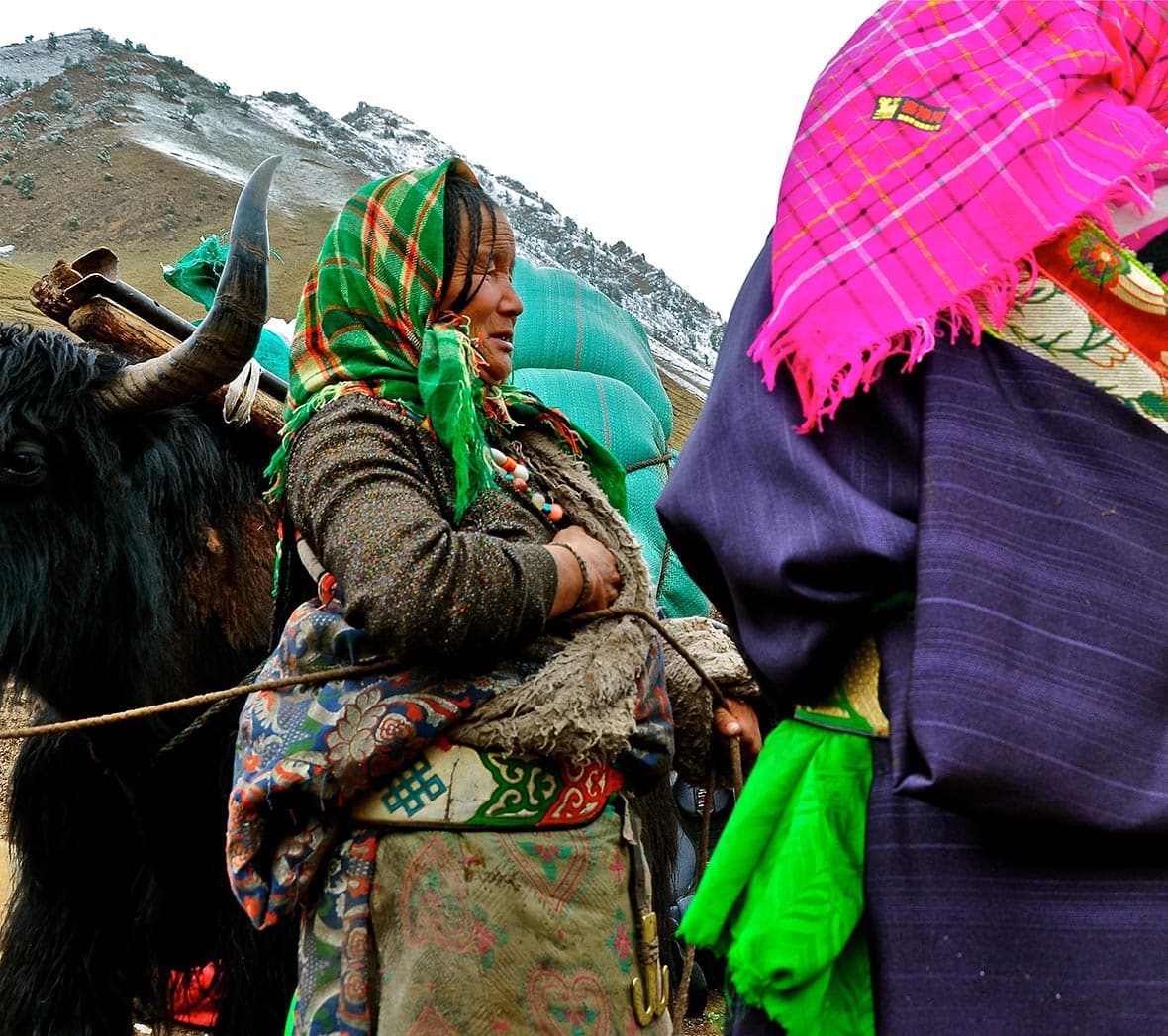
ABOVE: A nomadic headwoman, whose home lies in the shadows of the north side of the Amne Maqin range, listens to our guide’s tales.
Madoi the Cold, this place might be called. It might also be referred to as ‘Mado the Empty’ so vast and hushed it is. It is a rippling, wind blasted area where the elements of the sky share lordship of the place. Mado is one of the coldest counties in all of the Tibetan areas and snow can fall any day of the year – it is with no exaggeration to call it a place where the cold and snow dictate life. It is also a place of another white; it is a place of salt.
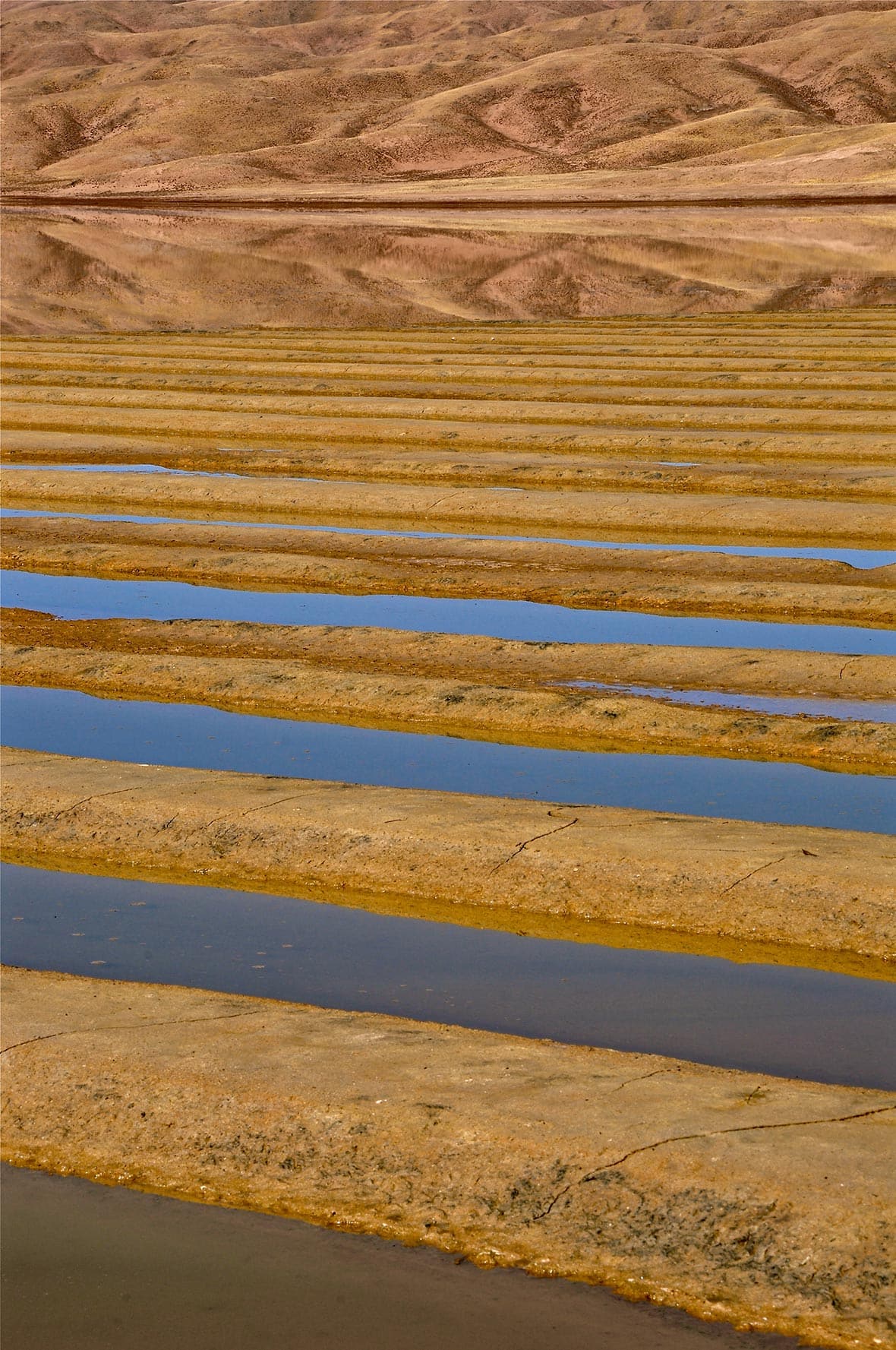
ABOVE: Fingers lie in a barren salt lake as a physical testament to days when these long humps would have salt scraped onto them, while the sun and wind would eliminate water and leave only the ‘white gold’.

Here is where the yaks would be loaded up – 100 kilograms of salt per yak.

It is only in the last two decades that any asphalt intrusions have appeared. Roads were built to link far away places within these far-flung lands and in almost all cases trade routes provided the blueprint for the roads.
Forty kilometers west of Madoi, Michael and I arrive to a hidden valley of silence at 4,300 meters, where even our old friend the wind has vacated – it is as though life and sound have been forsaken. I am expectant in this hushed place. We have come to one of the great ancient sources of salt for the nomads, Tsam Tso (Salt Lake), and a place that is unknown outside of those souls who traveled here.
Ahead of us, the shimmering earth ripples. Approaching closer, the shimmering becomes a glass surface of milky water reflecting a slightly smudged image of the sky above. With us is a local elder named Lobsang, a thickset man wearing an ill-fitting suit that struggles to contain his bulk.
“Nothing left”, he rumbles. “There is no longer any salt.” With his words come the dual prongs of sadness and relief. Joy that we can behold this lake and sadness that activity has long since died, that the salt is no longer. What remains are earthen fingers that push out into the still water like long forgotten docks. These were the salt-pans, where the salt-laden water was gathered to rest in shallow hollows. The thick iodine-free salt would be left after the sun evaporated the water. Only traces and smudges remain in this grand space.
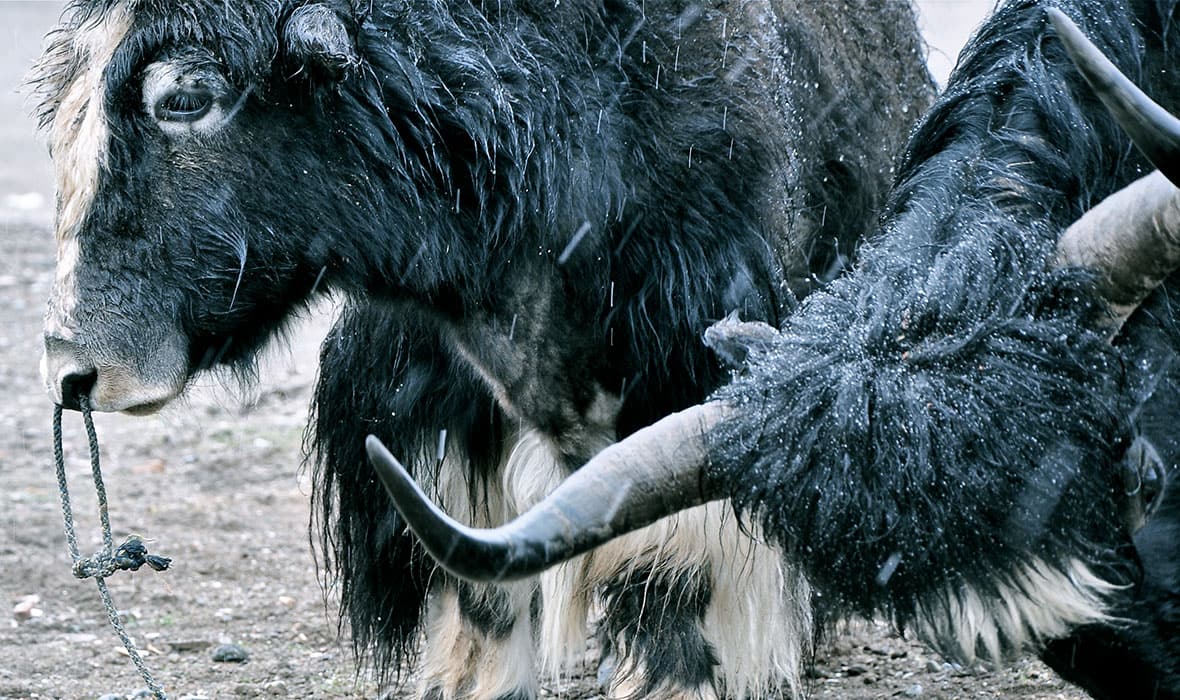
ABOVE: Our yak with some time off, while snow pellets begin to fall. Yak, mule, horses, and even sheep were used to travel and trade along the old mountain routes, though yak were the preferred transporters if they were to be found.
Though there are other more significant salt sources, like those north in Golmud, this was the salt that was most coveted. And besides, we’ve been walking for weeks to come to the salt lakes of the nomads.
Old Lobsang beckons to a portion along the lake. He is like a proud father, dressed up for the role and excited to show us a favorite child.
“Here is where the yaks would be loaded up – 100 kilograms of salt per yak.” I try in vain to imagine life milling about this still place, yaks and their keepers waiting their turn. There is no living thing in sight and even the ubiquitous undertakers of the sky – vultures – have faded from view.
Amne Machin – Sacred Kora
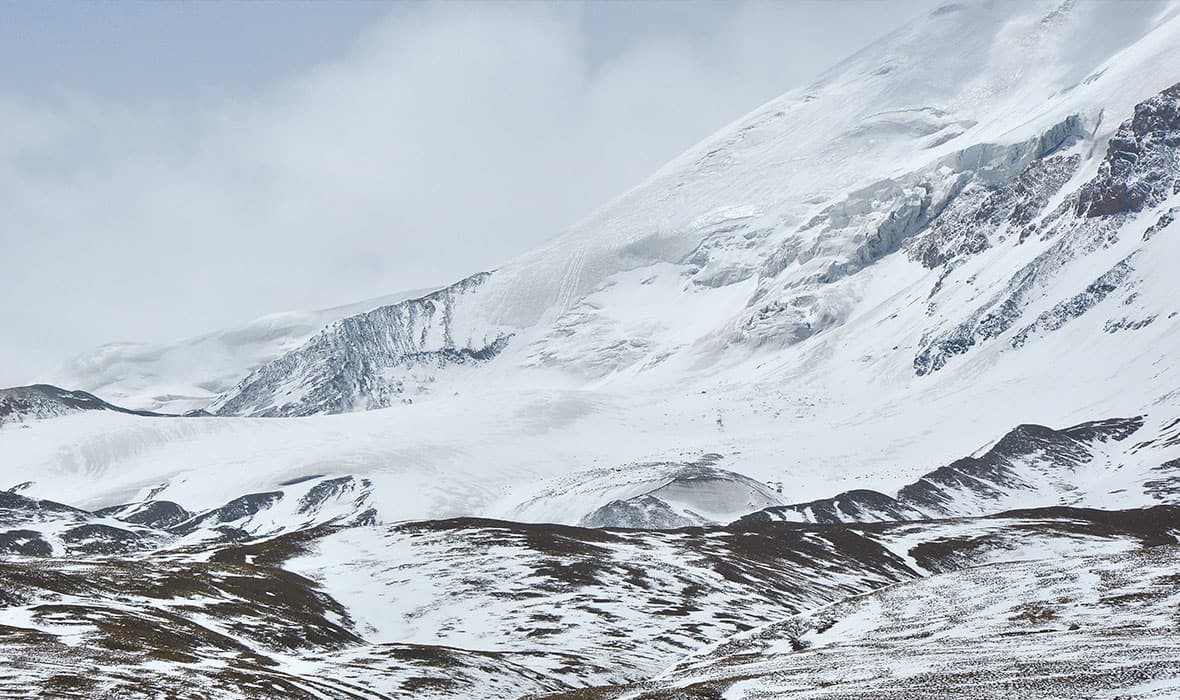
ABOVE: Day two of our trek around Amne Maqin and white lines mingle with the grasslands.
Traders, travelers and pilgrims alike never failed to add a touch of the divine into their journeys atop the plateau. Economics and the spiritual world often find themselves entwined within the Himalayas. Lying in between the nomadic communities of Kham and the Tsam Tso lies the sacred Amne Machin mountain. Circumambulating the 140 km bulk for Tibetan Buddhists is still considered the equivalent of wiping one’s very soul clean of sin. Traders coming for salt would use the opportunity to do half of the circuit on their way to the salt lake and complete the other half on their way back. In times of trade, reverence was essential to the lands and elements that allowed one to travel.
Michael and I decide that, like the traders of old, we must pay respects to the great deities in the sky. We must circumambulate the route and pay tribute as our own finale.
Worn and slightly shredded by the elements, we embark to pay homage to one of the great sacred mountains of the Tibetan world, Amne Machin.
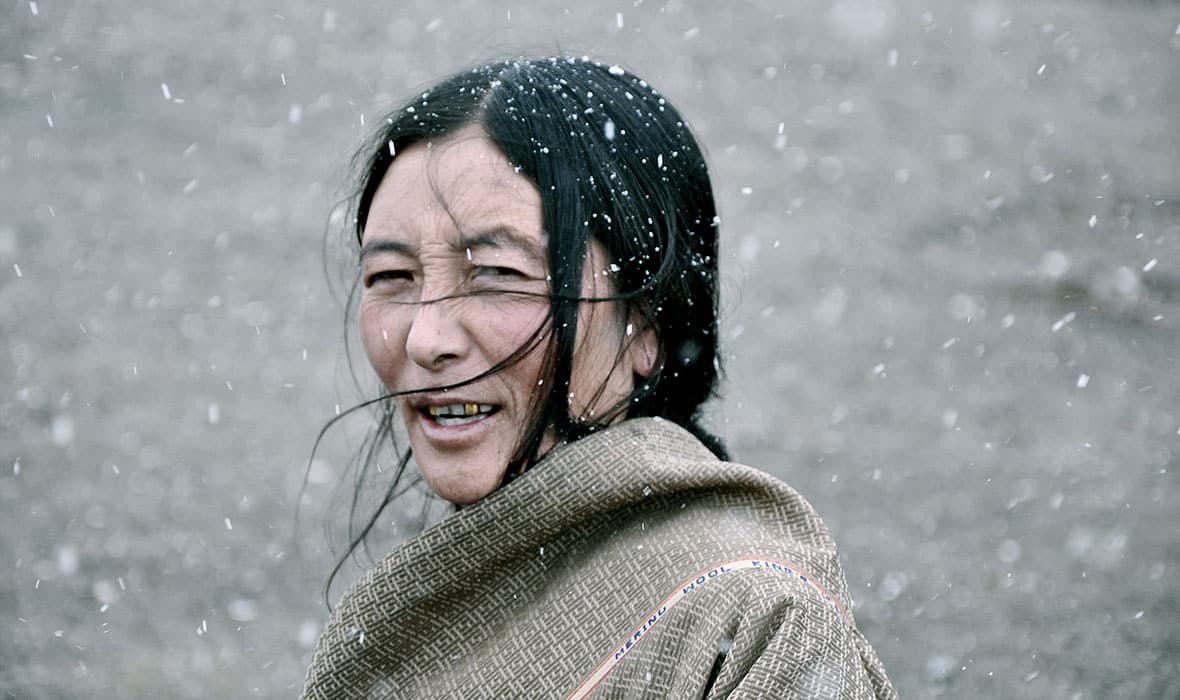
ABOVE: One realizes very quickly that women are in fact running the whole show in the mountains. Her words rang in our head for much of the journey, “Slowly, Slowly, and you will arrive.”
BELOW: Traversing a portion south of Amne Maqin, our yak pass over old snow that has been shorn down into a kind of crackling ice crust.
We are five days in, travelling with a mongrel terrier and being led by an absolute titan, Gamzon, a nomadic woman and our guide. We’ve been charged by wild dogs (which were repelled by our little terrier that I’ve called ‘Fritz’), woken to minus 10 Celsius in a threadbare tent, and we’ve subsisted on a diet of apples, raw onions, my unending stash of tea and noodles.
We are however locked into a contented sense of contented autonomy. Gamzon is always telling us that in the mountains, everything is “kalè kalè” or “slowly slowly”. It is one of the unwritten mantras of all mountain life, everywhere.
On that fifth day Gamzon swivels her horse to us screaming something, which is immediately taken by the wind.
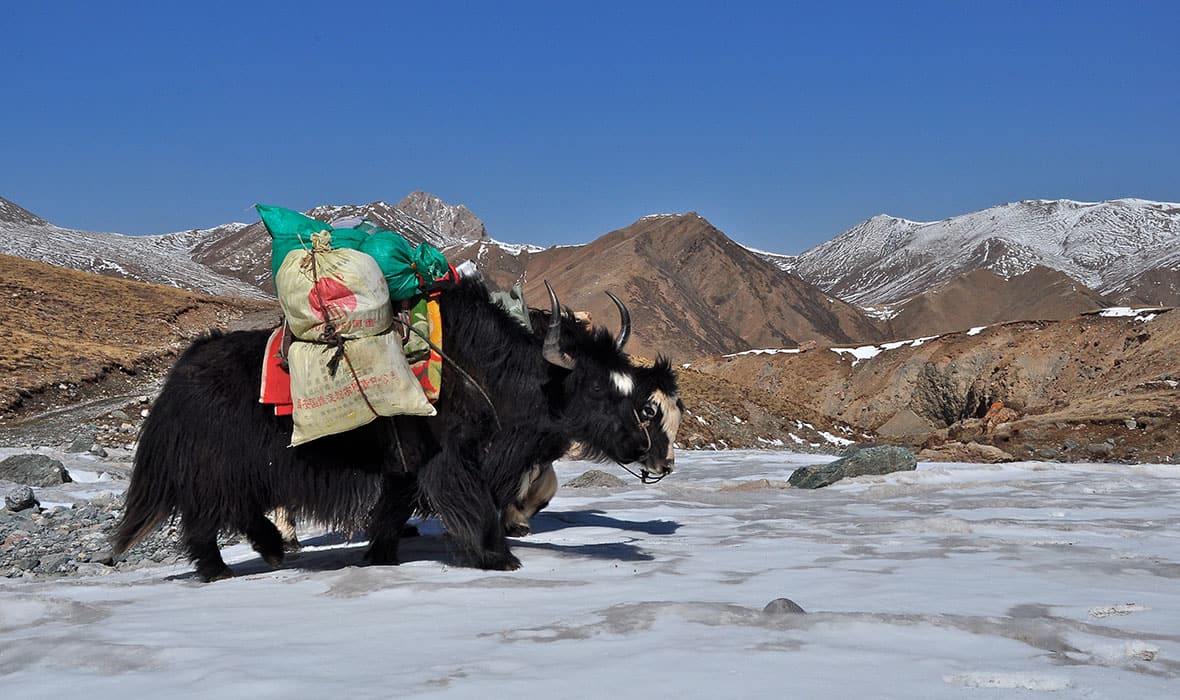
She repeats “Nom’sho,” pointing to a great valley that suddenly opens up before us.
Michael and I stop dead, and a sound comes out of Michael’s mouth. Before us is a valley of such width that the neither the eyes, nor the mind’s eye can take it all in.
On the right flank the white wall of the south face of Amne Machin range stretches into the distance. We have entered the southern empire of Amne Machin and its 6,230 meter peak. Below it, multiple lower peaks glitter with the wind’s force sending sprays of crystalline snow off into the sky.
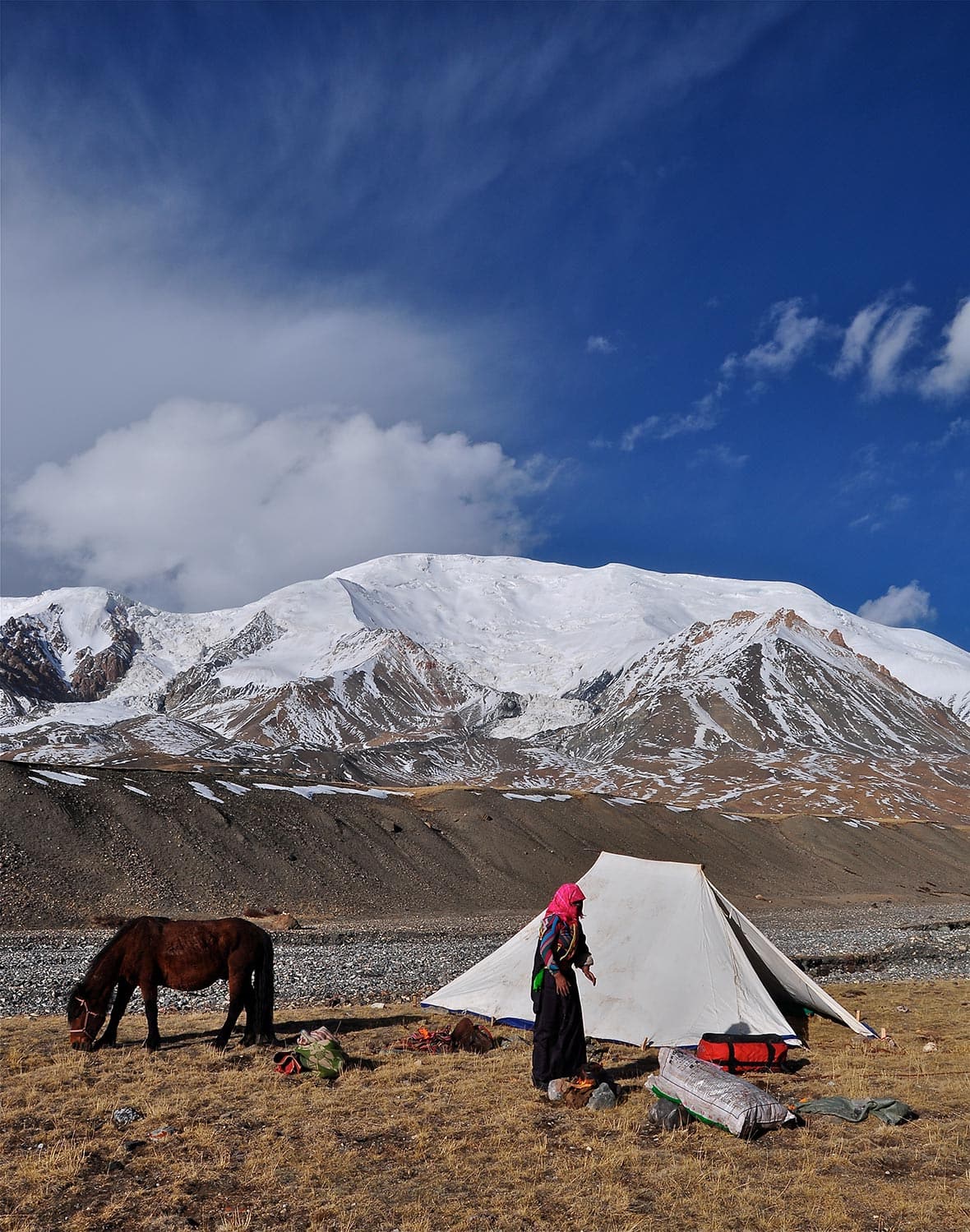
ABOVE: One of our camps beneath a portion of the Amne Maqin range, with the ever-present Gamzon in her pick head wrap.
Moving into the valley up onto a plateau of over 4,700 meters, the full extent of Nom’sho becomes evident. To the left is a chain of stone peaks called Mor’do, though they seem but hills compared to what they face. Something else catches the eye; it is a pathway that suddenly erupts out of nowhere wandering through the valley beyond the horizon. It is the ancient pilgrimage route.
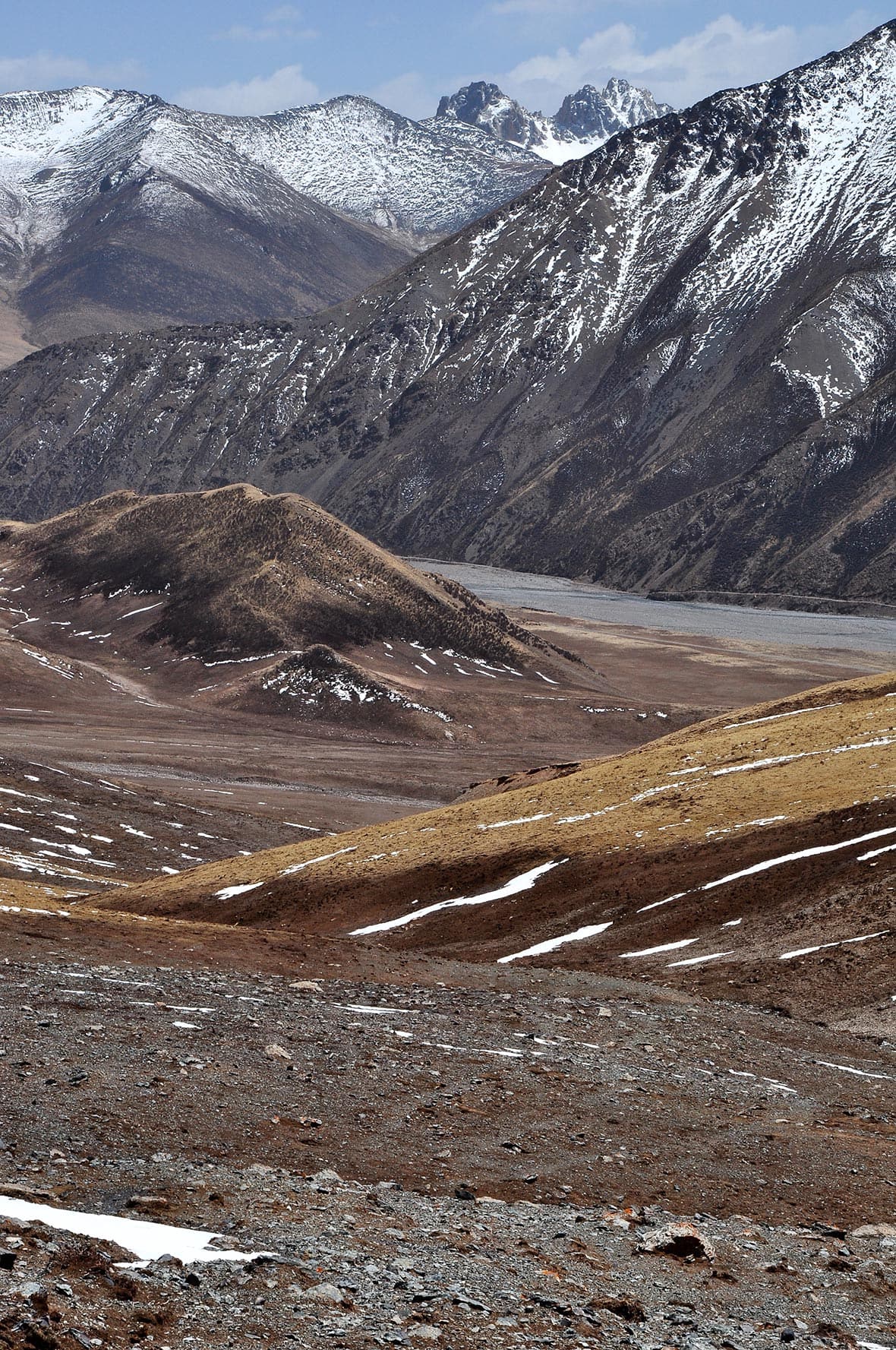
ABOVE: Traveling through the Himalayas one realizes quickly that the Tibetan adage, “there are no straight lines through the mountains” is adept.
I am reminded of something my Hungarian grandmother once said, “Never underestimate the importance of friction.” For whatever reason this bit of stark truth comes back looking at the landscape. Perhaps it is seeing the remnants and imagining the physical efforts of the pilgrims and traders. “What must they have felt upon reaching this point?” I wonder.
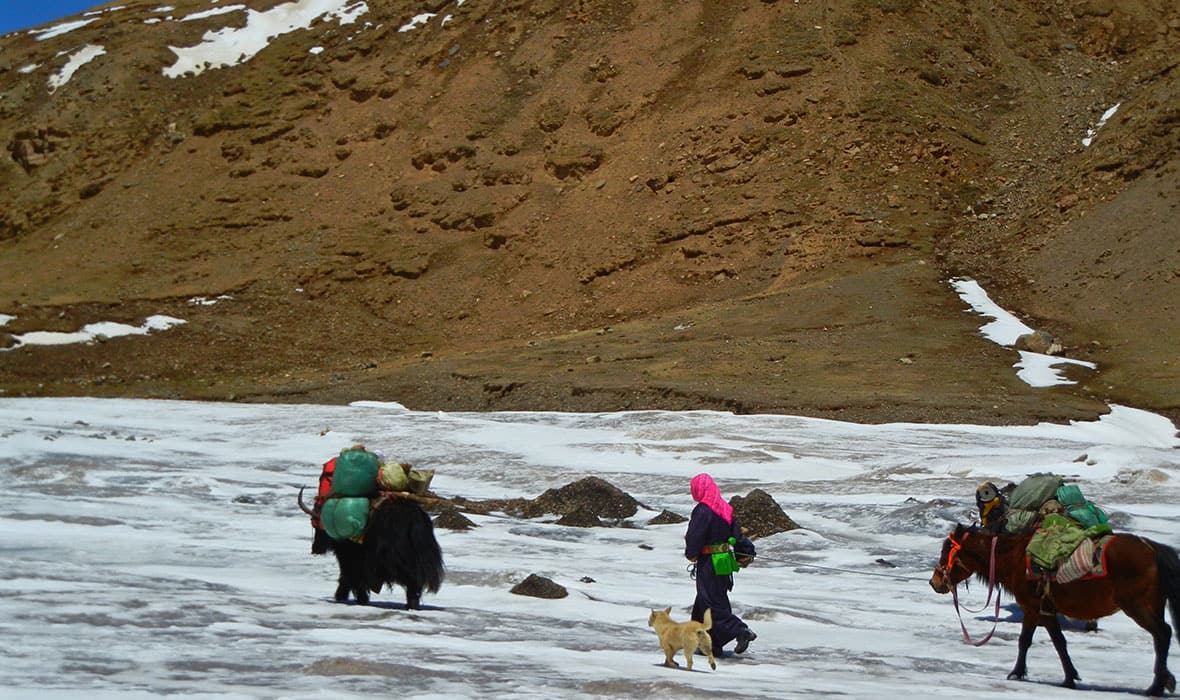
ABOVE: Gamzon, our two yaks, and little Fritz travel atop a portion of a frozen stream. Fritz remained with us for the entire journey around Amne Maqin and found nightly refuge in my sleeping bag.
We do make it around the proud mountain intact and it feels somehow correct that it ends on a note of reverence. Fritz and Gamzon leave us with a sniff and a nod respectively. It marks the end of over a month long journey by foot along portions of a route that has simply ebbed.
The efforts required to trade and transport (and indeed to pay respects) within such spaces has eased, but I cannot help but wonder if the great snow spires don’t miss seeing more of their trader friends passing below them with their white gold…as it was.
I pour another round of tea for Michael and I with the wind still roaring in my head.

